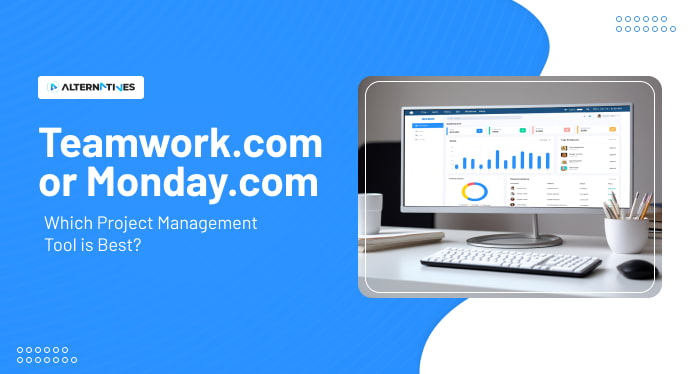Trello vs. Asana: In-Depth Comparison Guide

In the past few years, project management tools have become increasingly popular as a way to stay organized and efficient. But with so many options available, it can be difficult to determine which tool is best suited for you and your team. Trello and Asana are two of the most popular project management tools on the market, each offering unique features that can help you streamline your workflow. In this article, we will compare these two tools side-by-side to determine which one is best for you and your team’s needs.
A Quick Overview of Trello
Trello, a popular project management tool, boasts user-friendly features such as no-code automation, templates, two-factor authentication, unlimited boards, mobile device management, data export, and custom fields. With its intuitive interface, Trello simplifies collaboration and task tracking. Those looking for similar tools can visit Trello alternatives for a diverse range of project management tools tailored to their specific needs.
A Quick Overview of Asana
Asana, a robust project management tool, offers a comprehensive suite of features, including a calendar, Gantt chart, time tracking, reporting dashboard, forms, templates, and permissions. With its user-friendly interface, Asana facilitates efficient task management and collaboration. Users seeking alternatives for Asana with distinct features may explore here to find the platform that best aligns with their specific project needs.
Feature Comparison For Trello Vs Asana
| Feature | Trello Description | Asana Description |
| No-Code Automation | Employs Butler Power-Ups for basic automation, simplifying repetitive tasks and enhancing efficiency. | Offers advanced automation tools for creating intricate workflows, automating tasks, and improving overall productivity. |
| Templates | Provides a selection of board templates, though limited, for quick project setup and organization. | Extensive library of templates, catering to diverse projects, facilitates efficient initiation and structure for tasks and workflows. |
| Two-Factor Authentication | Boosts security with two-factor authentication, safeguarding user accounts against unauthorized access and enhancing overall account protection. | Ensures heightened security by implementing two-factor authentication, fortifying user accounts and bolstering overall platform security measures. |
| Unlimited Boards | Offers flexibility with an unlimited number of boards, allowing users to manage multiple projects concurrently and tailor organization according to their needs. | Facilitates managing an array of projects simultaneously by providing unlimited boards, ensuring scalability and adaptability to diverse project scopes. |
| Mobile Device Management | Supports mobile access through dedicated apps, ensuring seamless on-the-go project tracking and management for increased accessibility and convenience. | Ensures accessibility on mobile devices with a user-friendly interface and dedicated apps, optimizing project tracking and collaboration anytime, anywhere. |
| Data Export | Enables data export in JSON format, promoting data analysis and backup options for users seeking insights or safeguarding information outside the platform. | Offers flexibility by allowing users to export data in various formats, facilitating analysis, and reporting, and providing backup options for enhanced data security. |
| Custom Fields | Incorporates basic custom fields to enhance task details and organization within boards, allowing users to tailor their project tracking to specific needs. | Features advanced custom fields, empowering users to customize project tracking with intricate details, offering a high degree of flexibility and organization. |
| Calendar | Integrates with calendars, providing a date-based view for tasks and deadlines, enhancing project planning and coordination within the platform. | Presents an in-built calendar, streamlining project timelines and deadlines visualization for improved planning, coordination, and efficient task management. |
| Gantt Chart | Offers limited Gantt chart functionality, providing a basic visual representation of project timelines and task dependencies within the platform. | Delivers a comprehensive Gantt chart, allowing users to visualize and manage project timelines and dependencies with greater detail and precision. |
| Time Tracking | Features basic time-tracking tools for task management, enabling users to monitor work hours and deadlines at a fundamental level. | Boasts robust time tracking tools, allowing for accurate monitoring of work hours, task progress, and adherence to project deadlines with precision. |
| Reporting Dashboard | Provides basic reporting features through Power-Ups, offering insights into project performance and progress, though not as advanced as some competitors. | Empowers users with an advanced reporting dashboard, offering comprehensive insights into project performance, progress, and key metrics for informed decision-making. |
| Forms | Allows limited form creation capabilities, enabling users to gather basic information within the platform but lacking the depth of customization seen in other tools. | Supports customizable forms for capturing project details, facilitating efficient data collection and enhancing the platform’s adaptability to various project requirements. |
| Permissions | Offers basic permissions for boards and tasks, allowing users to control access levels to a certain extent, though not as granular as some alternatives. | Provides granular permissions, allowing precise control over access levels at both project and task levels, enhancing security and collaboration within the platform. |
| Pricing | Trello offers 4 subscription plans as free, standard, premium, and enterprise. The Pricing starts at $5 per month and can go up to $17 per month. | Asana offers 3 subscription plans as personal, starter, and advanced. The Pricing starts at $10.99 per month and can go up to $24.99 per month. |
| Advanced Reporting | Trello’s reporting is relatively basic compared to Asana. | Asana offers advanced reporting tools, allowing users to delve deeper into project data for more comprehensive analysis. |
Trello Vs Asana: Feature Comparison
1. No-Code Automation
Trello and Asana both offer powerful no-code automation features, allowing users to streamline workflows without extensive coding knowledge. In Trello, the no-code automation is robust, offering versatile automation possibilities through intuitive workflows. Asana, on the other hand, provides a user-friendly interface for creating automated processes and simplifying task management. While Trello focuses on comprehensive customization, Asana excels in simplicity, catering to users seeking efficient automation solutions tailored to their specific needs with ease.
2. Templates
Trello offers an extensive template library, covering various project types, ensuring swift project initiation. It allows for detailed customization within templates, adapting to diverse workflows. On the other hand, Asana provides a visually intuitive template creation process, emphasizing ease of use. While Trello excels in providing a wide array of pre-built templates, Asana prioritizes a user-friendly template creation experience, catering to users who prefer quick and visual setups.
3. Two-factor Authentication
Both Trello and Asana prioritize security with two-factor authentication (2FA). Trello integrates 2FA seamlessly into its login process, adding an extra layer of protection for user accounts. Similarly, Asana emphasizes user security by offering robust 2FA options, enhancing account safeguarding. While Trello ensures a straightforward 2FA implementation, Asana complements it with user-friendly configurations, providing users with flexible yet robust authentication options to reinforce the security of their project management accounts.
4. Unlimited Boards
Trello’s unlimited board’s feature allows users to create and manage an extensive number of boards, promoting comprehensive project organization. Similarly, Asana provides flexibility with unlimited boards, empowering users to structure projects without limitations. While Trello emphasizes versatility and customization, Asana focuses on providing users with the freedom to scale their project management and adapt to changing requirements seamlessly with an unlimited number of boards.
5. Mobile Device Management
Trello’s mobile app ensures users can manage tasks on the go, maintaining productivity from anywhere. Similarly, Asana’s mobile capabilities allow users to stay connected and oversee projects effortlessly on mobile devices. While Trello focuses on providing a comprehensive mobile task management experience, Asana emphasizes a user-friendly interface, making it easy for users to access and manage projects seamlessly through their mobile devices for efficient remote collaboration.
6. Data Exports
Trello and Asana prioritize data management with robust data export features. Trello enables users to export project data efficiently, supporting detailed analysis and backup needs. Simultaneously, Asana offers comprehensive data export options, facilitating effective project data management. While Trello emphasizes seamless data extraction for various purposes, Asana complements this by providing users with versatile export capabilities, ensuring that project data can be easily utilized for analysis, reporting, and external use in a format that suits their specific requirements.
7. Custom Fields
Trello and Asana empower users with customizable task details through their robust custom field features. Trello provides extensive customization, allowing users to track unique data within tasks with precision. Conversely, Asana offers flexible custom fields, emphasizing simplicity in creating and managing task-specific information. While Trello excels in comprehensive customization, Asana prioritizes an intuitive approach, ensuring users can effortlessly adapt task details to their specific project needs, enhancing overall flexibility and efficiency in project management on both platforms.
8. Calendar
Trello and Asana integrate powerful calendar features for effective project scheduling. Trello’s calendar provides a visual representation of tasks and deadlines, aiding in project timeline management. Conversely, Asana offers an intuitive calendar view, ensuring users can easily oversee project schedules. While Trello excels in comprehensive timeline visualization, Asana emphasizes simplicity in calendar navigation, catering to users who prefer a straightforward approach to managing and organizing tasks within a visual timeline for enhanced project planning and coordination.
9. Gantt Chart
Trello’s Gantt Chart offers an interactive visual representation of project timelines and dependencies, facilitating detailed project management. In comparison, Asana provides a user-friendly Gantt Chart experience, simplifying timeline navigation for users. While Trello emphasizes comprehensive timeline visualization and intricate project planning, Asana focuses on delivering an accessible and straightforward Gantt Chart interface, catering to users who prefer a visually intuitive approach to project timeline management.
10. Time Tracking
Trello and Asana offer robust time-tracking features to enhance project efficiency. Trello’s built-in time tracking allows for precise monitoring and management of project timelines. Similarly, Asana provides seamless time tracking capabilities, ensuring accurate recording of work hours. While Trello focuses on comprehensive time management with detailed insights, Asana emphasizes simplicity, allowing users to effortlessly track and analyze time spent on tasks for efficient project planning and resource allocation on both platforms.
11. Reporting Dashboard
Trello’s dashboard offers detailed analytics, providing in-depth project performance metrics. Conversely, Asana’s reporting dashboard emphasizes a visually intuitive display of project data, simplifying data interpretation. While Trello excels in comprehensive analytics for detailed insights, Asana focuses on delivering a user-friendly interface, ensuring that users can easily access and understand project metrics, and facilitating efficient decision-making and project optimization on both platforms.
12. Forms
Trello and Asana enhance data collection with versatile Forms features. Trello offers customizable forms to streamline data gathering for projects. In contrast, Asana provides a visually intuitive form-creation process, simplifying data input. While Trello emphasizes extensive customization, enabling users to design detailed forms, Asana prioritizes a user-friendly interface, ensuring users can efficiently create and utilize forms for data collection tailored to their project needs on both platforms.
13. Permissions
Trello and Asana prioritize project security with robust Permissions features. Trello offers granular permissions, allowing precise control over user access to boards and tasks. Similarly, Asana ensures secure project access with customizable permissions. While Trello focuses on comprehensive control options, empowering users to define access at a detailed level, Asana emphasizes a straightforward approach, making it easy for users to manage project permissions efficiently according to their specific collaboration needs on both platforms.
14.Pricing
Trello and Asana provide diverse subscription plans to cater to different user needs. With regards to Trello pricing, it offers a free plan and paid options, starting at $5 per month for the standard plan, and going up to $17 per month for the enterprise plan. If we look at Asana's pricing plan it offers a personal plan for free users and two premium options, starting at $10.99 per month for the starter plan and going up to $24.99 per month for the advanced plan. Both platforms ensure flexibility in pricing, accommodating users with varied requirements and budget considerations.
15. Advanced Reporting
Trello’s reporting tools offer detailed insights into project data, facilitating comprehensive analysis. Conversely, Asana provides advanced reporting capabilities, ensuring users can delve deeper into project metrics. While Trello excels in extensive reporting options for thorough analysis, Asana focuses on delivering a user-friendly interface, ensuring that users can easily access and interpret advanced project reports, enhancing overall project visibility and decision-making on both platforms.
Trello Vs Asana – Which is Better?
Choosing between Trello and Asana depends on your team’s specific needs and preferences. Both platforms excel in project management, offering unique features. Here’s a comparison to help you decide which might be better suited for your organization.
For better-informed decisions, it’s advisable to explore Trello reviews before choosing the tool. Similarly, to gain insights into user experiences with Asana, consider checking out Asana reviews for valuable perspectives and feedback from users.
What makes Trello different from Asana:
- User-Friendly Interface: Trello’s simple and intuitive interface makes it easy for teams to adapt quickly.
- Visual Task Management: Visual boards and cards enhance the clarity of tasks, simplifying project tracking.
- Flexibility with Boards: Trello allows unlimited boards, providing flexibility for diverse project structures.
- Customization: Robust customization options, including custom fields, offer tailored task details.
What makes Asana different from Trello:
- Comprehensive Task Management: Asana’s task management features are extensive, supporting detailed project planning.
- Advanced Reporting: Powerful reporting tools provide in-depth insights for project analysis.
- Gantt Chart Functionality: Asana excels with an interactive Gantt chart, aiding in visualizing project timelines.
- Workflow Builder: Asana’s workflow builder allows for customized and automated processes.
Why Trello Might Be Better
- Ideal for smaller teams or those new to project management.
- Simplicity suits agile workflows and quick task tracking.
- Visual learners find the board layout more intuitive.
Why Asana Might Be Better
- Suitable for larger teams requiring extensive task management features.
- Advanced reporting and analytics for detailed project insights.
- Gantt charts and robust time tracking enhance project planning and execution.
Frequently Asked Questions
What is Trello?
Trello is a user-friendly project management tool that utilizes boards, lists, and cards for task organization. It provides a visual and collaborative platform for teams to manage projects efficiently.
What is Trello used for?
Trello is used for organizing tasks and projects collaboratively. Its visual interface allows teams to create boards, add tasks on cards, and move them through lists, streamlining project workflows.
What is Asana?
Asana is a versatile project management platform designed for teams to coordinate and manage tasks effectively. It provides a centralized space for collaboration, task assignment, and project tracking.
What is Asana used for?
Asana is used for project management, task tracking, and team collaboration. It facilitates efficient communication, assignment of tasks, and tracking of project progress, making it a comprehensive project management solution.
Is Trello and Asana free?
Yes, both Trello and Asana offer free plans with limited features. Users can access basic functionalities, making it suitable for smaller teams or personal use.
What is the pricing of Trello and pricing of Asana?
Trello offers four subscription plans starting at $5 per month and going up to $17 per month. Asana has three plans starting at $10.99 per month, with the advanced plan priced at $24.99 per month. Each platform offers tiered pricing to accommodate different user needs.
Conclusion
In conclusion, Trello and Asana are leading project management tools, each with distinct strengths. Trello excels in simplicity, visual task management, and flexibility, making it ideal for smaller teams. Asana, on the other hand, offers advanced features, comprehensive task management, and detailed analytics, catering to larger teams with complex project requirements. The choice between them depends on team size, project complexity, and preferred management style.



